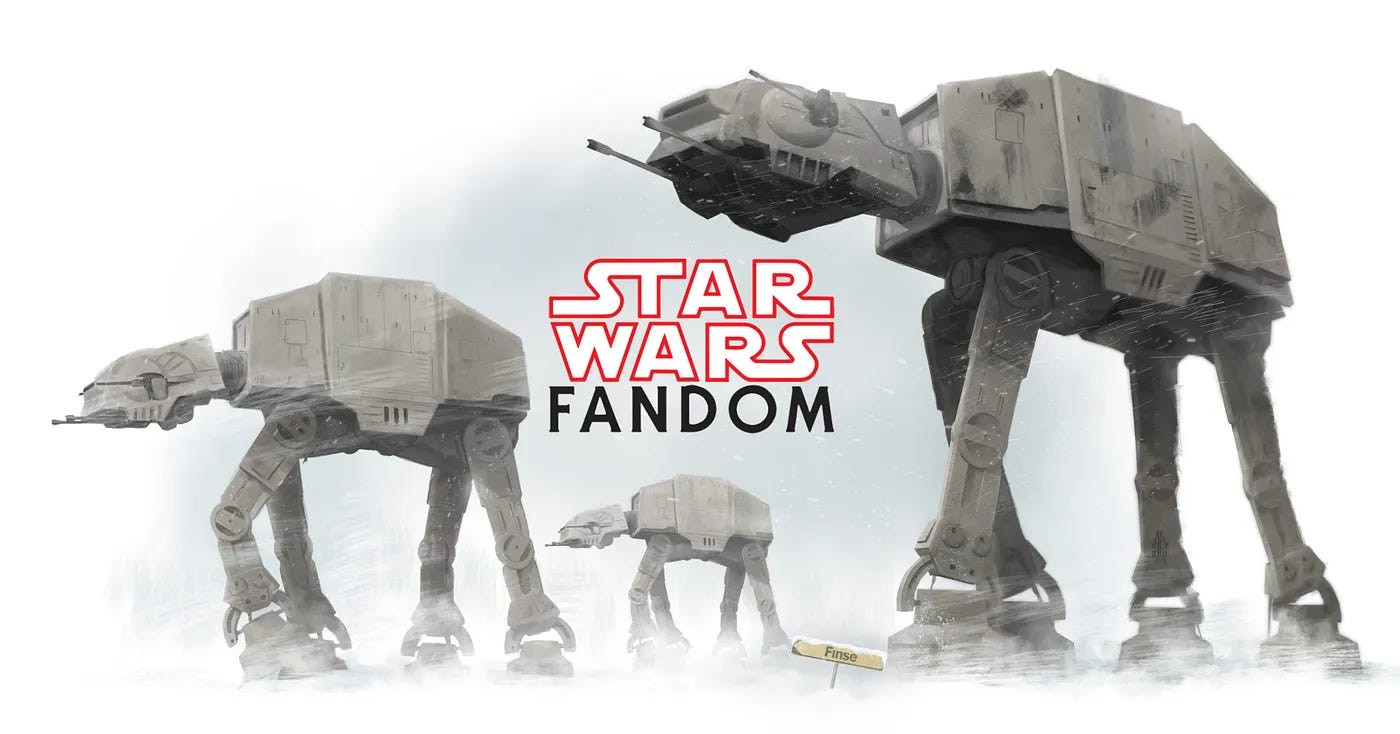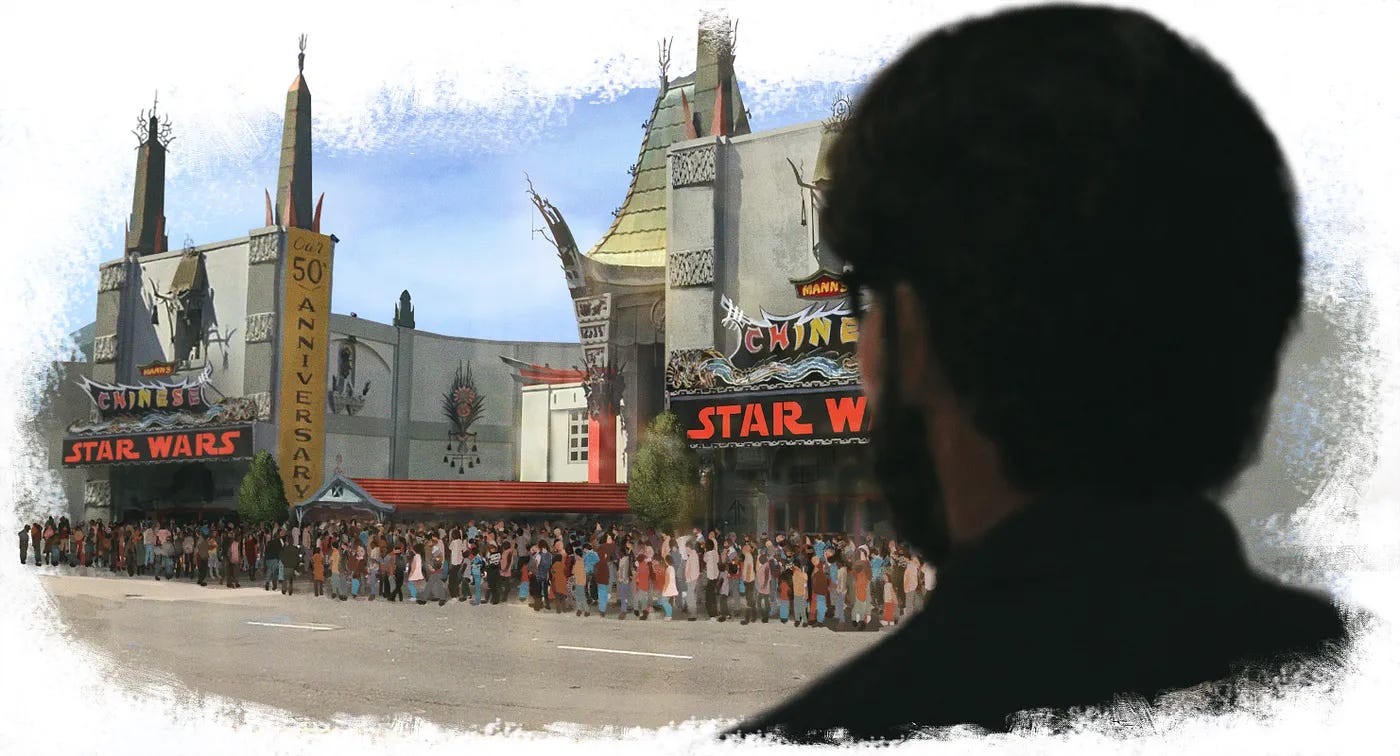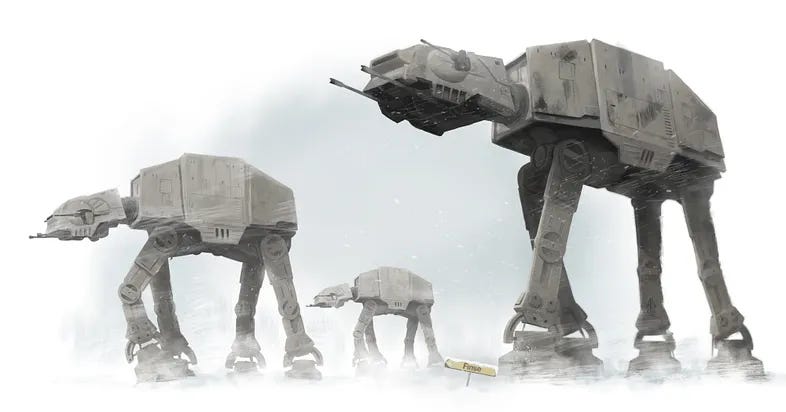Exploring the Star Wars Fandom
Joy, Passion, and Frustration in a Galaxy Far, Far Away…

“I thought Star Wars was too wacky for the general public.”
— George Lucas
On May 25, 1977, a young filmmaker dines quietly in a Hollywood Boulevard restaurant. He’s part of the rebellious New Hollywood wave, and while he’s known for being reserved and a little nerdy, he’s also talented, sporting a beard, glasses, and a haircut that seems to have a mind of its own. He’s not yet an industry powerhouse and, honestly, isn’t much interested in becoming one; his dream lies in making experimental films — or, perhaps even better, in becoming a racecar driver… if it hadn’t been for that accident.
Across the street, a crowd has gathered outside Grauman’s Chinese Theatre. The sidewalk is a chaotic blend of eager moviegoers and curious onlookers, with police redirecting traffic to accommodate the massive line stretching from the ticket booth around the block. They’ve come to see this filmmaker’s latest project — a film he had no faith would ever succeed. Even now, as he watches this crowd, he can hardly believe it.

A Fandom is Born
“Luminous beings are we, not this crude matter.”
— Yoda (Frank Oz), The Empire Strikes Back
That filmmaker was George Lucas, just 33 years old, staring out at a phenomenon he never saw coming. He’d poured his heartinto what he thought of as a “space fantasy,” a low-budget experiment inspired by the adventure serials he loved as a kid. Growing up, Lucas would escape with characters like Buck Rogers and Flash Gordon every Saturday morning. These heroes — these adventures— would inspire him for life.
But Star Wars was a brutal production, marred by everything from budget issues to near-constant technical setbacks. Lucas, disillusioned and exhausted, had almost given up hope. The film he imagined initially had a much longer and cumbersome title (Adventures of Luke Starkiller, as taken from the Journal of the Whills, Saga I: The Star Wars), but after a bit of nudging from friends, including a young Steven Spielberg, who had recently released his own little film he called Jaws, he settled on Star Wars. Still, Lucas was making his film with little expectation of success.
Star Wars’ success was a case of the right place and the right time. The U.S. was still grappling with the scars of the Vietnam War, and the Watergate scandal’s reverberations had left the public wary of authority and the political elite. In this climate of skepticism and pessimism, Star Wars offered a sweeping, hopeful escape — a journey into a galaxy where good could triumph, where heroes rose against the odds.
It became a story for the ages, capturing the hearts of millions and sparking a fandom that would grow, thrive, and even splinter over the decades. The Star Wars fandom was born.
What is Fandom?
“You must unlearn what you have learned.”
— Yoda (Frank Oz), The Empire Strikes Back
So, what exactly is “fandom”? It’s not a word that shows up in our daily vocabulary, but for millions, it’s a world in itself. Let’s unpack it without diving too deeply into theory.
Here’s a quick breakdown: Fandom generally refers to the activities and social connections that emerge around certain brands or media. It’s a community where fans come together, sharing their enthusiasm and building a network around their shared interests. Fandom thrives when the brand or activity provides “identity value” — in other words, when it helps people connect with and express parts of their own identity.
Star Wars, Harry Potter, The Hunger Games, and even sports teams all inspire fandom. The same goes for Porsche, Harley-Davidson, and Tesla. They each provide something unique that fans can relate to and integrate into how they see themselves. Meanwhile, the milk you grab from the grocery store probably doesn’t spark this kind of connection — though, who knows, maybe there’s someone out there who’s obsessed with dairy, has milk carton posters on their walls, and dreams about rare artisanal cheeses. (Hey, no judgment here, but that would be a very different kind of article!)
A Theoretical Perspective
“Time it is for you to look past a pile of old books, hmm?”
— Yoda (Frank Oz), The Last Jedi
Alright, let’s dig a little deeper. The term “fan” originally comes from “fanatic,” but today, it reflects an intense passion rather than a strictly religious fervor. While there are similarities between fandoms and religious communities, joining a fandom doesn’t equate to religious belief.
For many fans, sharing their enthusiasm is a natural step. YouTube and social media are filled with content created by fans — videos, fan art, and endless discussions — all dedicated to their favorite brands, characters, or stories. When enough fans share and engage like this, a network begins to form, solidifying the fandom.
In Superfandom: How Our Obsessions Are Changing What We Buy and Who We Are, authors Aaron M. Glazer and Zoe Fraade-Blanar break down some of the essential elements of fandom. The first is “fan objects” — physical items representing the fan’s dedication to a brand or character, like collectibles, posters, or even celebrity autographs. Then there are “fan texts,” which are more abstract, including experiences, songs, or even ideas related to the fandom. Fans use both these objects and texts to express their passion and strengthen their connection to others within the fandom.
So, what’s the “formula” for building a fandom? Glazer and Fraade-Blanar suggest that a successful fandom requires:
Emotional response + effective communication + critical mass.
In other words, when enough people genuinely love something and have the means to discuss and share it, a fandom is born.
The Revenge of the Nerds
“Who’s scruffy looking?”
— Han Solo (Harrison Ford), The Empire Strikes Back
Alright, enough theory!
There was a time when fandom was seen as distinctly “uncool.” Fandoms and their passions were often relegated to the sidelines, and the “cool kids” would never be caught dead as part of one. But over the past couple of decades, and especially with the rise of high-speed internet and social media, the tables have turned. Nerd culture has not only gained acceptance but has become mainstream.
We could debate the role of series like The Big Bang Theory and Stranger Things in bringing nerd culture into the spotlight — and whether they truly represent real “nerds.” But one thing is clear: these shows have helped normalize fandoms for everyone, even those on the outside. Standing out has become more than acceptable; it’s a point of pride. Video games are in almost every home, board games are thriving, and RPGs like Dungeons & Dragons have gone mainstream.
This change in status is perhaps best highlighted by the D&D community itself. Once a niche pastime, D&D has attracted a long list of well-known players, including Henry Cavill, Vin Diesel, Jon Favreau, and James Franco. Even Stephen Colbert, Felicia Day, Mike Myers, and Joe Manganiello are known fans, further pushing nerdiness and fandom into the spotlight. Seeing household names sharing their nerdy side has only added to the allure of fandom, showing that passion is worth celebrating — no matter how scruffy the fandom might look.

Bad Guys Doing Good
“Aren’t you a little short for a Stormtrooper?”
— Princess Leia Organa (Carrie Fisher), A New Hope
A prime example of fandom in action is theStar Warsfan organization known as the501st Legion, founded in 1997 by American fans Albin Johnson and Tom Crews. This non-profit organization, with the motto “Bad Guys Doing Good,” has members worldwide, grouped into local chapters called “garrisons.” The members build their own costumes — most often the iconic white Imperial Stormtrooper armor or other “villain” costumes from theStar Warsuniverse — and use these to do good in their communities.
From visiting children’s hospitals to attending Star Wars premieres, 501st Legion members bring joy wherever they go, whether by making appearances at fan conventions, lending a little excitement to charity events, or, in the case of the Nordic Garrison, arranging annual “pilgrimages” to Finse in Norway, where the winter scenes in The Empire Strikes Back were shot. George Lucas himself, an honorary member of the Legion, even gave the organization a unique place within Star Wars lore.
In Revenge of the Sith, Anakin Skywalker’s regiment of Clone Troopers in the assault on the Jedi Temple was designated the 501st — a nod to their charitable work in the real world.
The 501st Legion also brought their talents directly to the screen. When the Disney+ series The Mandalorian needed Stormtrooper extras, who better to fill the ranks than fans who live and breathe the role? In their own meticulously crafted armor, members of the 501st Legion took on Imperial duties for real, showcasing just how closely fandom and official Star Wars productions can intersect.
The Darker Side of Fandom
“That’s not how the Force works!”
— Han Solo (Harrison Ford), The Force Awakens
Unfortunately, not all fans use their passion for positive ends, and the Star Wars fandom has long had its darker side.
They say no one hates Star Wars quite like a Star Wars fan. I can’t say who coined this phrase first, but it’s likely a result of frustrations with endless rants about “Han shot first,” debates over how “Ewoks ruined everything,” or arguments about which film or series “destroyed” the franchise. Today, we can practically set a clock to it: whenever a new release drops — Star Wars or otherwise — a backlash of organized “review bombing” and online hostility is sure to follow. Log onto any social media platform after a new Star Wars release, and you might believe Star Wars is the greatest cultural plague of our time.

This tension isn’t new. Even The Empire Strikes Back — now widely considered the crown jewel of the franchise — faced its share of backlash when it debuted in 1980. Imagine the outcry it might have faced in today’s social media climate. (“What!? His father!? I hate George Lucas! Everyone, give it 1 star on IMDB!”)
Maybe each Star Wars film and series just needs time to “cool off” before fans can appreciate it fully. Take the Prequel Trilogy (1999–2005). Older fans initially criticized these films, but over time, they’ve gained a warmer, even nostalgic, reputation. For many fans who grew up in the early 2000s, the Prequels were their entry into the galaxy far, far away. The animated series The Clone Wars also helped more fans embrace the Prequels, cementing them as an integral part of the Star Wars universe.
The Toxic Side of Fandom
“Fear leads to anger, anger leads to hate. Hate leads to suffering.”
— Yoda (Frank Oz), The Phantom Menace
It’s not unusual to see strong reactions when a new Star Wars film or series debuts. These stories convey powerful identity myths, so fans often form deep personal beliefs about how Star Wars “should” unfold. When a new release diverges from these expectations, it can feel to some fans like more than just a disappointment — it can feel like a betrayal, especially when beloved characters act in surprising ways. This frustration, amplified by the megaphone of social media, sometimes leads to waves of intense negativity.
Star Wars has, unfortunately, seen more than its share of toxic backlash. Ahmed Best, who played Jar Jar Binks in The Phantom Menace (1999), faced such intense online harassment from both fans and media that he was pushed to the brink of suicide. Jake Lloyd, the ten-year-old who portrayed young Anakin Skywalker, was relentlessly bullied at school, which led him to quit acting and, according to some, may have amplified his struggles with mental health. Even “The Maker” himself, George Lucas, reportedly stepped away from the franchise for years — ultimately selling Star Wars to Disney — partly because of the hostility some fans directed at him over the Prequels.
More recently, The Last Jedi (2017) encountered its own backlash. Though the film earned praise from critics and many fans, a vocal segment of the fandom lashed out, generating a flood of hostility online. Actress Kelly Marie Tran was especially targeted, facing such a deluge of sexism and racism that she eventually left social media. And on the small screen, The Acolytestar Amandla Stenberg also endured intense online harassment, with an outpouring of racist and misogynistic comments.
One explanation for this phenomenon is how social media has a knack for turning up the volume on negative voices while muting the positive ones. This echo chamber effect often creates an “us vs. them” mentality, feeding into an exaggerated divide between “old” and “new” Star Wars fans. Controversy, of course, also sells: a scathing rant will reliably attract more clicks than any balanced critique. The internet has coined terms like “rage farmers” and “rage baiters” for those who’ve made negativity a profitable art form. For many fans, it may even seem easier to embrace a ready-made opinion — nicely packaged in a thick layer of outrage — than to come up with one from scratch. Sadly, many influencers capitalize on this trend, expertly crafting outrage-laden content to keep engagement sky-high.
A New Hope
“This is the way.”
— Din Djarin (Pedro Pascal), The Mandalorian
Like the families at the heart of Star Wars, the fandom can sometimes feel a bit… dysfunctional. But when it shines, this community has the power to change lives, offering connection and purpose in an often chaotic world. Despite divided voices, for better or worse, the Star Wars community remains a testament to the power of shared passions.
So, can such a passionate (and occasionally splintered) fandom really find harmony? Is there a balance somewhere in the Galaxy? I believe there is. For all the noise about Disney and Lucasfilm’s stewardship of the franchise, Star Wars has never been more popular, and a new generation is steering it forward. Fans-turned-creators like Dave Filoni, mentored by Lucas himself, have brought us The Clone Wars, Rebels, and Ahsoka. Jon Favreau, a lifelong fan, has carved new paths with The Mandalorian and The Book of Boba Fett. And we saw the return of Ewan McGregor as Obi-Wan Kenobi in, well, Obi-Wan Kenobi.
Then there’s Tony Gilroy — better known for his spy thrillers than “space fantasies” — who delivered Andor, a series that many regard as one of the franchise’s best. The Acolyte, and upcoming shows like Skeleton Crew promise even more variety, giving us fresh perspectives and exploring different genres and eras within the galaxy. New films are on the horizon too, bringing back The Mandalorian, Grogu, Rey Skywalker, and even the ancient origins of the Jedi at the beginning of the Star Wars timeline.
For all the bumps along the way, the fandom has a bright future. Without George Lucas’s little “space fantasy,” we wouldn’t have this galaxy far, far away to keep exploring, debating, and enjoying.
But here we are, and for that, I’ll always be grateful.
Thank you to Andreas Nor for creating the artwork for this article. Check out his website at norillustrasjon.com.

Thank you to Andreas Nor for creating the artwork for this article. Check out his website at norillustrasjon.com.
Sources:
George Lucas: A Life by Brian Jay Jones, 2016
Superfandom: How Our Obsessions Are Changing What We Buy and Who We Are by Aaron M. Glazer and Zoe Fraade-Blanar, 2017

